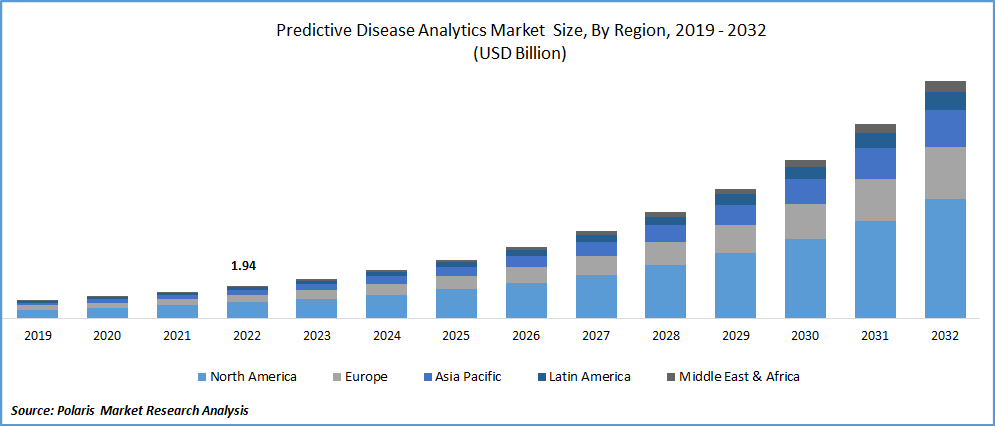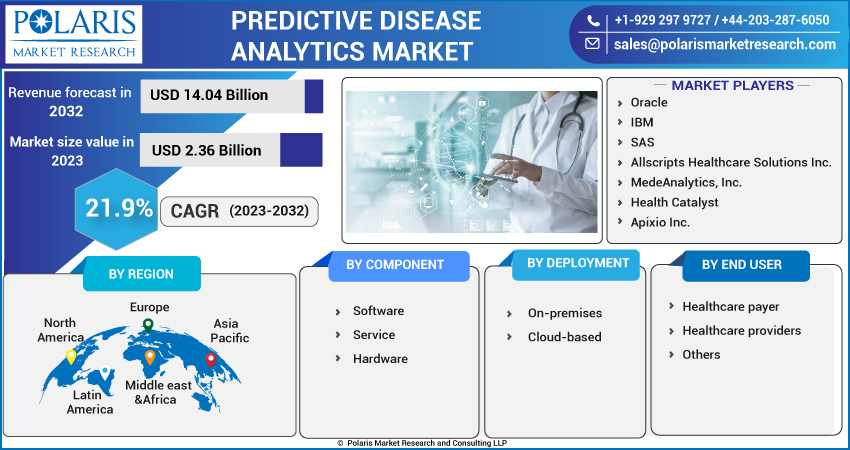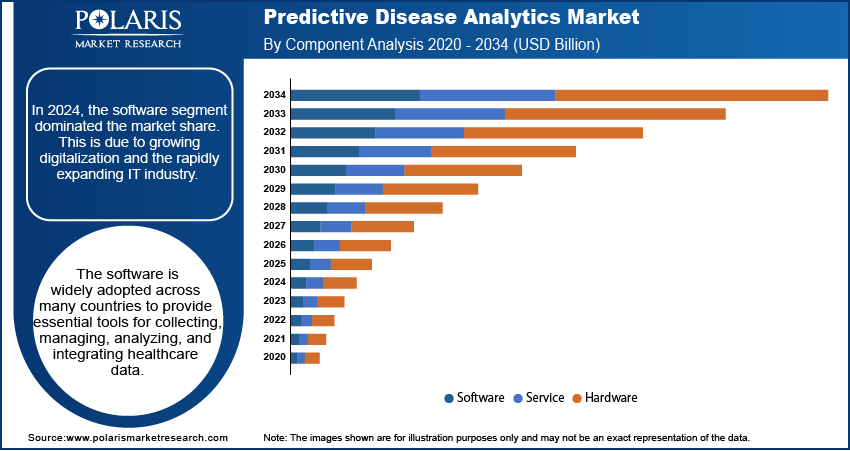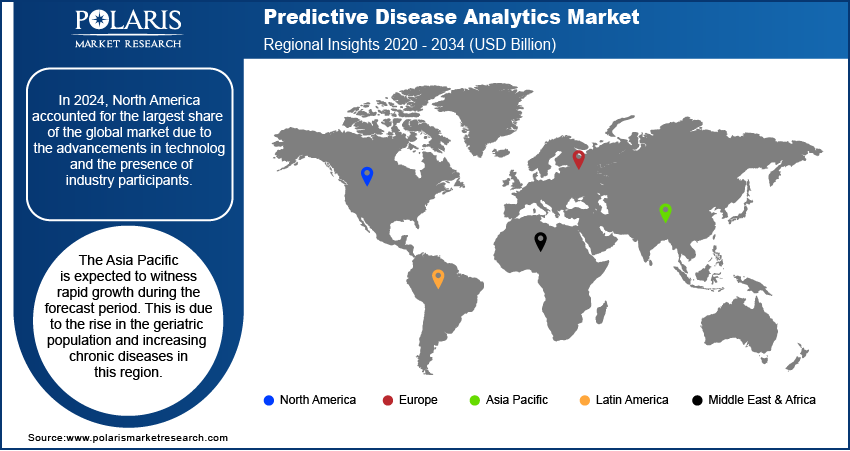
Predictive Disease Analytics Market Share, Size, Trends, Industry Analysis Report
By Component (Software, Service, and Hardware); By Deployment; By End User; By Region; Segment Forecast, 2025 - 2034
- Published Date:Sep-2025
- Pages: 130
- Format: PDF
- Report ID: PM3377
- Base Year: 2024
- Historical Data: 2020-2023
The global predictive disease analytics market was valued at USD 2.86 billion in 2024 and is expected to grow at a CAGR of 21.9% during the forecast period. Key factors driving the demand include rising cases of chronic diseases, increasing government support, and technological advances.
Key Insights
- The software segment dominated the market share in 2024. This is due to the rise in digitalization and the rapid expansion of the IT industry.
- The on-premises segment held the largest global share in 2024. This is due to various benefits such as security, data privacy, customization, performance, and latency.
- In 2024, North America accounted for the largest share of the global market due to the advancements in technology and the presence of industry participants.
- The Asia Pacific is expected to witness rapid growth during the forecast period. This is due to the rise in the geriatric population and increasing chronic diseases in this region.
Industry Dynamics
- Growing urban pollution from vehicles, industries, and construction is accelerating demand for Soil amendmentss in densely populated areas.
- Smart city projects worldwide are integrating real-time air monitoring into sustainable infrastructure, supporting digital transformation and urban resilience.
- High costs of advanced monitoring systems limit adoption, especially in developing regions where budgets are tight but pollution levels are severe.
- Rising smart city investments create demand for scalable, IoT-enabled air quality sensors that provide real-time data for urban planning.
Market Statistics
- 2024 Market Size: USD 2.86 billion
- 2034 Projected Market Size: USD 20.64 billion
- CAGR (2025-2034): 21.9%
- North America: Largest market in 2024

To Understand More About this Research: Request a Free Sample Report
AI Impact on Predictive Disease Analytics Market
- Algorithms of AI analyze vast and complex datasets, from genomic data to lifestyle data, to identify patterns that are not easily identifiable.
- AI improve and refine clinical trial processes with identification of the right data for studies and predicting their response to medication.
- It provides hyper-personalized health insights by pre-analyzing data on individual patients against population-level medical data trends. This enables practitioners to develop a tailored screening schedule and preventative strategy for patients.
- AI-enabled tools are expected to automate data analysis and provide actionable insights with support providers to identify high-risk patients, thereby enabling easy management of care while ensuring effective resource allocation.
Growing technological advancements in the market are revolutionizing the overall healthcare industry. Several businesses are adopting artificial intelligence to improve their revenue streams. For example, in April 2022, Biofourmis raised US$ 300 million to scale up its virtual care offerings, including delivering personalized and predictive in-home care and expanding its services to patients with complex chronic conditions. Technology is fundamental in global health care as predictive analytics has become more useful in personal medicine, operational management, and epidemiology. The shift toward artificial intelligence has had a tremendously positive impact on the global market.
The increasingly pervasive use of predictive analytics in various healthcare applications results in better-individualized patient care, earlier interventions, and lower hospital expenses. Importantly, the technology already benefits a range of healthcare settings, including the biggest university institutions, healthcare insurance firms, and small private medical practices. Predictive analytics capabilities are currently prevalent in electronic health record (EHR) systems, and analysts anticipate that companies will continue to expand their offerings.
Healthcare professionals can use these predictive analytics techniques to identify the possibilities for making operational & clinical decisions that are more efficient in predicting trends and even controlling the spread of diseases. This is accomplished through the examination of both historical & current healthcare data.
COVID-19 has accelerated the growth of the global market due to the rising adoption of digitalized health solutions for patients and growing investments in them. The need for these analytics has heightened with the increasing importance of early detection and intervention in infectious diseases. Moreover, machine learning models can analyze large amounts of data from diverse sources, such as EHRs, public health databases, and social media, to identify patterns and risk factors associated with COVID-19 infection and outcomes.

For Specific Research Requirements, Speak With the Research Analyst
Industry Dynamics
Growth Drivers
Spur in the adoption and launches of predictive analytics are set to escalate the predictive disease analytics market growth. The remarkable properties of solutions and appropriate patient care and outcomes have enhanced the demand for analytics in the healthcare industry. As a result, several businesses are contributing to the market. For example, in December 2022, human health data provider Net Health Systems introduced the RADAR care management system, which involves predictive models that harness the power of machine learning (ML) ‘s ability to recognize patients at a high risk of hospitalization, pressure ulcers, mortality, and falls. Adopting these solutions among a huge population is propelling the market’s revenue.
Increasing cases of chronic diseases are another factor fuelling the growth of the predictive analytics market. According to the CDC, chronic diseases are the foremost causes of death and disability in the U.S. Nearly 60% of adults have at least one chronic disease. For example, as per the National Association of Chronic Disease Directors, chronic conditions like cancer, diabetes, and cardiovascular disease are the primary causes of death in the United States. The growing prevalence of chronic disease is improving the need for analytics to identify the risk of developing chronic conditions.
Report Segmentation
The market is primarily segmented based on component, deployment, End User, and region.
|
By Component |
By Deployment |
By End User |
By Region |
|
|
|
|
To Understand the Scope of this Report: Speak to Analyst
Segmental Analysis
Component Analysis
In 2024, the software segment dominated the market share. This is due to growing digitalization and the rapidly expanding IT industry. The software is widely adopted across many countries to provide essential tools for collecting, managing, analyzing, and integrating healthcare data. A large number of businesses are also investing in this segment. For instance, in April 2021, Well Sky introduced a new predictive analytics service, “CareInsights,” for personal care. This service analyses personal care to present providers with an inclusive view of crucial factors.
Most businesses across the globe use data analytics divisions to function their tools and services for future trends properly. Most analytic firms offer a full range of services to businesses. Extending the services provided by data analytics boosts the segment's growth even further.

Deployment Analysis
In 2024, the on-premises segment held the largest global share. This is attributed to various benefits such as security, data privacy, customization, performance, and latency. On-premises solutions offer greater flexibility and customization options, allowing organizations to tailor their predictive disease analytics software to their needs and workflows. Depending on the size and complexity of the data being analyzed, an on-premises solution is faster and more efficient than a cloud-based solution that relies on internet connectivity.
End User Analysis
Healthcare payers are the leading contributors to market development, as this segment primarily comprises insurance businesses, government agencies, & health-plan sponsors, and use these predictive tools are used to evaluate insurance claims, detect fraud claims, & evaluate disease risk assessment. As a result, most healthcare payers rely on analytics, which is why this segment is gaining huge momentum. As per a recent study, nearly 83% of healthcare practitioners believe that such predictive tools are one of their top strategic priorities.
Regional Analysis
North America Predictive Disease Analytics Market Analysis
North America accounted for the largest share of the global market in 2024. This is linked to advancements in technology and the prominence of industry participants, remarkably in the United States. The substantial funding provided to new players by venture capitalists is likely to fuel market growth. Augmented healthcare expenditure in the region is one of the key aspects of improving global revenue. For example, U.S. spending on healthcare increased from 2.7% in 2021 & reached around USD 4.3 trillion. As a share of the nation's Gross Domestic Product, health spending accounted for almost 18.3%.
Intensifying innovations in predictive analytics development techniques are anticipated to be key opportunities for well-known players. The proliferation of advanced technologies such as machine learning, artificial intelligence, and big data will likely boost market growth during the forecast period.
Asia Pacific Predictive Disease Analytics Market Insights
Asia Pacific is expected to grow fastest during the forecast period due to the geriatric population and increasing chronic diseases in this region. With longer life expectancies and lower fertility rates, Asia Pacific is at the forefront of one of the most important global demographic trends. For example, by Census Bureau data published in June 2022, there were projected to be nearly 414 million Asian people aged 65 and older, around 20% higher than the total U.S. population (331.4 million). Older adults are often at risk for social isolation, which can lead to a range of negative health outcomes.
Analytics solutions help identify individuals at risk for social isolation and connect them with resources and services that can help them stay engaged with their communities. Subsequently, a growing older population is increasing the risks of various diseases, hence the demand for predictive analytics solutions. This is further responsible for augmenting the growth of the global market.

Key Players & Competitive Analysis Report
Predictive disease analytics landscape is fiercely competitive as stakeholder intelligence and strategy matters when it comes to market evolution and performance. Viable vendor strategies currently revolve around strategic placements of AI spending, and partnerships based on a competitive positioning. A large revenue opportunity exists to identify market segments in development such as real-world evidential marketplaces, and preventative care where clear market expansion exists. However, addressing key industry drivers are important for vendor solutions as these shape the sustainable future of innovative and emergent commerce. Vendor solutions would need to evaluate necessary data privacy structures and interoperability as keys for continuing growth. Expert’s believe industry growth will belong to those who build sustainable vendor value chains and can demonstrate real improvements in patient outcomes as the future could center around patient based ecosystems.
The global predictive disease analytics market involves Oracle, IBM, SAS, Allscripts Healthcare Solutions., MedeAnalytics, Health Catalyst, and Apixio Inc.
Recent Developments
- March 2024: UMass Memorial Health collaborated with Google Cloud to leverage AI, machine learning, and advanced data analytics to bring personalized care to cardiometabolic patients.
- March 2022: Databricks introduced a new lakehouse platform. This platform is for data management, analytics & advanced AI use cases like medical image classification, disease prediction, & biomarker discovery.
- November 2022: Zephyr AI partnered with MedStar Health to further advance its AI-based insights product, transforming the lives of chronically ill patients.
Predictive Disease Analytics Market Report Scope
|
Report Attributes |
Details |
|
Market size value in 2024 |
USD 2.86 billion |
| Market size value in 2025 | USD 3.46 billion |
|
Revenue forecast in 2034 |
USD 20.64 billion |
|
CAGR |
21.9% from 2025 – 2034 |
|
Base year |
2024 |
|
Historical data |
2020– 2023 |
|
Forecast period |
2025– 2034 |
|
Quantitative units |
Revenue in USD billion and CAGR from 2025 to 2034 |
|
Segments covered |
By Component, By Deployment, By End User, By Region |
|
Regional scope |
North America, Europe, Asia Pacific, Latin America; Middle East & Africa |
|
Key companies |
Oracle, IBM, SAS, Allscripts Healthcare Solutions Inc., MedeAnalytics, Inc., Health Catalyst, and Apixio Inc. |
FAQ's
The predictive disease analytics market report covering key segments are component, deployment, end-user, and region.
Predictive Disease Analytics Market Size Worth USD 20.64 Billion By 2034.
The global predictive disease analytics market expected to grow at a CAGR of 21.9% during the forecast period.
North America led the global market in 2024.
key driving factors in predictive disease analytics market are rising cases of chronic diseases.
